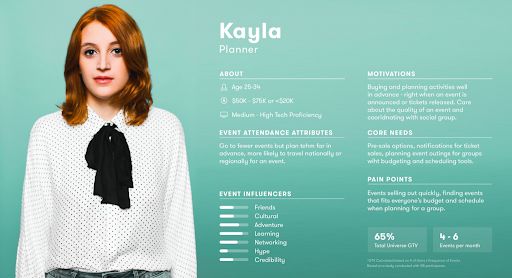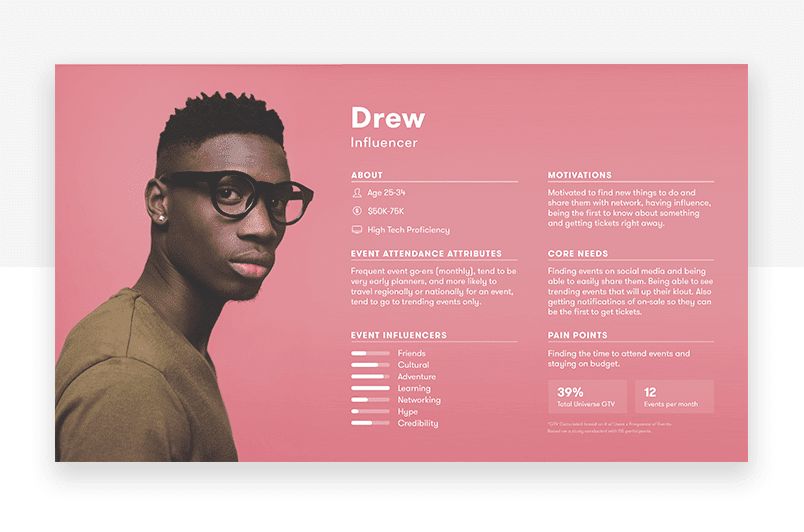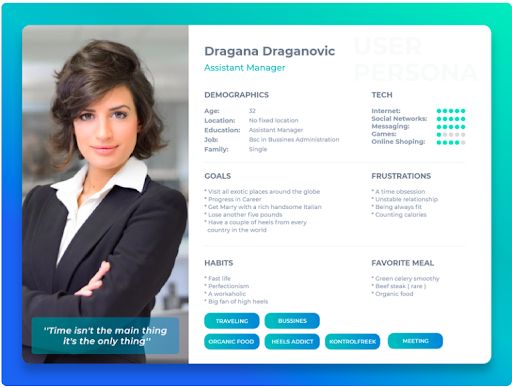
The Art of Microinteractions: Enhancing User Engagement & Delight
15 Oct 2023
How well do you know your ideal customers? Can you describe them? Do you know their needs, what motivates them and where they spend time? The better you can define your ideal customers, the easier it is to create user experiences that really hit the mark. That’s why you need to create user personas.
User personas are semi-fictional representations of your ideal customers based on real data and insights about demographic, behaviour patterns, motivations and goals.
Each user persona represents a significant group of people in the real world, so the designer or marketer can focus on a memorable cast of users instead of thousands of forgettable individuals.
In this way, user personas aid UX designers and marketers to create different experiences for different types of people, ultimately ensuring they design for a specific somebody to create experiences they will love.
When Alan Cooper decided in 1983 to write software that could be used by non-programmers, he did something different – something that would end up being used by user experience (UX) designers, marketers and businesses for decades to come. He developed personas for each user group, giving them a name and goal. The first user persona was called “Kathy Traffic”.
Using this user persona method, Alan Cooper developed more programs for satisfied customers. He then decided to share his method in his book, The Inmates Are Running the Asylum in 1998. Since then businesses around the world have been creating user personas to improve how they design, develop, market and sell.
There can be some confusion around personas, so here are some truths to keep in mind:
User personas do have:
Everyone from UX design teams and interaction designers to marketers, sales teams and product developers can benefit from user personas to improve what they do and make experiences better for users.
If you know what your personas are trying to achieve, the challenges they face, their pain points and different needs, you can create products and services to help them reach their goals. Personas allow design and product managers to make sure they are creating products, services, designs and user experiences that suit the needs and preferences of each different user.
Creating a user persona helps you work out keywords, topics and channels for content and search marketing. You can identify where your best customers spend time online (and offline), so you can be there too, with the right messages.
The process of developing and sharing user personas ensures the whole company is on the same page when it comes to who your customers are. Every department and level of the business – from senior management to the sales floor – will have a consistent and specific understanding of each target group who will use your product.
Personas provide better understanding of where users spend their time, where they go for information, which social networks they use and when. All of this information enables you to make sure you are targeting and promoting your products or services in places where your users will see them.
In the UX design process, empathy is a core value if designers want to make something that really solves users problems. A user persona helps UX designers to create a deeper level of understanding and empathy with users, seeing things from their perspective, so they can identify with the user they are designing for. This makes designers more likely to want to create the best product and design solutions for them.
A user persona is usually presented as a one-pager document that communicates and summarises research trends and patterns in a way that is easy to visualise.
Take a look at this example of a user persona:

It covers everything you need to know in one succinct page.
There’s an endless list of elements you can include depending on your business and goals. At the very least, every user persona should include these characteristics:
Give a name that sounds like a real person, not something like “Jackie of All Trades” which sounds more like a cartoon character.
Put a face to a name. Avoid celebrities or known characters as this can form stereotypes or preconceived ideas. Show the individual in a typical user environment that gives insight into where your product or service fits into their life. A dad might be at his home office, a student in the classroom, and so on.
Write a backstory for your persona. Summarise their history, how they spend their time, why they do what they do for work, and add some unique traits. This requires you to put yourself in their shoes and look at life from their perspective.
Including details like where they live, age, family status, job and level of seniority, education and more.
Here’s a sample from HostGator, which describes Jill Anderson as a 35-year-old regional director, single and lives in Portsmouth.

Do they love a challenge? Are they fearful and nervous or impulsive and bold? Think about the personality traits they have. For B2B, you can include workstyle traits, such as “enjoys negotiation; data and facts driven”.
You can approach the personality section in a few ways:

Understand how your customer thinks. What motivates them to take action? Are they motivated more by fear or growth? You can use a sliding scale here to visualise data.
This example from Universe User Personas outlines Drew’s motivations, core needs and pain points clearly:

Highlight goals that your persona may have that relate to your product/service and outside the realm of your product or service. What is their end goal with the product? What are their life goals?
Take a look at how this example lists the goals of Dragana Draganovic:

Highlight their pain points. Question things like: What is preventing your persona from achieving their goals? What concerns do they have? This section will prove critical when it comes to honing your design, so you can meet the needs of customers.
You’ll notice that in our example personas throughout this article, not every persona has the same elements. That’s because personas are unique to the business or brand that creates them.
There are plenty of extra characteristics you can include that you might not find in a user persona template. Your goal when creating personas is to ensure yours are relevant to your business and the products or services you are designing, which means you can add and remove elements from the persona template as needed.
Some additional elements you might want to include:
Where do they spend their time? Include details of social media platforms, websites, browsers and apps they use in their day-to-day. Web data and analytics will help you here.
Summarise your persona in a simple motto that they might say.
What brands do they buy? Which influencers do they follow?
What media does your customer base consume? What does their typical bookshelf look like? What type of music or podcasts do they listen to? What type of television do they watch?
See how this example for a music app includes favourite bands and favourite music related platforms:

“Personas, like all powerful tools, can be grasped in an instant but can take months or years to master.” – Alan Cooper
There are lots of methods to create user personas and they all rely on lots of user research.
According to specialist in personas, Dr Lene Nielsen, there are 10 steps in creating a persona. She explains in her Interaction Design Foundation encyclopaedia article, Personas, how this is the ideal process but it is not always possible to include all the steps in the project.
Below is an outline of Nielsen’s steps:
The first step is to find as much knowledge about your users as possible:
Use focus groups and online surveys to get to know real customers across different user types. As Adele Revella, Buyer Persona Institute, said: “If we don’t interview Buyer Personas, we don’t know anything.”
They are on the frontline and can tell you about the smoothest and toughest sells, customer pain points and the most common questions they’re asked.
Go to Quora and Reddit to find common questions and challenges for your target users. Customers use forums to vent, so you’ll quickly see the frustrations and pain points people are experiencing.
Do user research on social media platforms, such as LinkedIn, Twitter and Instagram. See people’s interests (personal and professional) and what they care about.
Web analytics, competitive intelligence, customer support logs and social media data can be used to help create the persona and fill in the gaps.
You might use quantitative data to confirm other information, such as demographics like gender, age and income. Surveys are a good way to do this.
Compile and analyse research findings to form a hypothesis. Use a worksheet to document and collect all data in one place. You should now start to see trends and behaviour patterns in the information. Find a set of people clustering across up to eight variables. These grouping trends will help you bring similar people together and build a picture of each user group to form the basis of each persona.
Share the user groups you have so far with project team members and other stakeholders and question them to see if everyone agrees.
Decide how many personas you will create based on your hypothesis. Do you only need one persona? Or four? You want to cover all bases here of your top personas and avoid creating variations of each others.
Bring everything together and describe your user persona. Don’t just list facts and features ; weave those facts into a detailed representation of who this persona is as a person. Use stories to provide context and a deeper understanding of who this person is.
As Don Norman put it: “[personas] only need to be realistic, not real, not necessarily even accurate (as long as they accurately characterise the user base).”
Some valuable advice here is to keep it concise. That way anyone in the company should be able to quickly look at the persona and understand the information.
Create scenarios that describe solutions, such as a “A day in the life.” You might be describing a number of situations, or use cases, that could trigger use of the product or service. You’re placing the persona in a specific context with a problem they want to solve or goals they want to achieve.
Involve the project participants to get their acceptance of the personas. Their buy-in is incredibly important, as the whole business – not just the design team – should be able to benefit from using personas.
Share the personas across the business. Put them into design so they can be shared in an easy-to-digest way. Use illustrations, icons and design elements to highlight persona information, make it memorable and visually engaging.
This user persona example shows how design can make an impact:

Think about design features that will make it easy to compare the persona groups, for example you might use sliding scales to define user traits, such as whether they are adventurous or risk-averse.
This example from designer Martha Eierdanz shows how the information is consistent between personas, so it’s easy to compare them quickly. Pay attention to the clean design features, including simple iconography.

A persona is only a valuable business tool if you create scenarios that put the persona in the story. Scenarios fill in the “why” behind the “who” – they are stories about the persona using whatever has been designed to achieve the task or goal (such as a website or app).
For example, a scenario might tell the story of how persona Sarah uses an app to make a pet insurance claim. Scenarios can vary in level of details, but should always outline ‘who’, ‘what’, ‘when’, ‘where’, ‘why’, and ‘how’.
The thing about user personas is that they might never be “done”. Continue to add to them, refine them and iterate as much as you need to get value from them. You might need to rewrite personas, create new ones or get rid of outdated ones as your end users and business evolve.
Take a good look at everything you can find around your target audience and their user needs when you research and create a user persona.
Start with what you have and go from there. You can fill gaps as you go.
Pay attention to not just what someone is doing, but why they’re doing it. When doing research and building a persona, look at why someone is using a particular product, looking for a specific solution, or trying to reach a certain goal—and not just the tools, solutions, or goals themselves.
Don’t define your persona by describing one real person – no one person can embody all your target audience. Remember, personas are semi-fictional characters.
All other personas are secondary. Focus on researching, creating and targeting your primary persona first.
Very few businesses only target one audience for their product, so chances are you’re going to need to create more than one user persona. But be careful you don’t fall into the trap of trying to capture everyone by creating dozens of user personas. The more you create, the more they overlap and resemble each other, and the less value you will get out of the process.
For this reason, we recommend limiting yourself at four user personas. Four is more than enough to give you insight into the majority of your audience segments. If you only need one, only create one.
Make one of these the primary persona, and follow the rule “design for the primary – accommodate the secondary.”
User personas are powerful tools. The end goal is to really get to know your users, giving you insights that can help inform and guide the product development process.
Take the time to do them properly and you can add value at every stage of the design process by ensuring the person is kept at the heart of every decision. But their value goes beyond UX. Once you have created your user personas, share them with the business, so they can be used to create experiences, products and services that people love.
For more help with your user persona template and creating user personas, contact our team.

A forward-thinker by nature, Ryuji’s vision is motivated by his experience and ingenuity. Having worked at the forefront of digital design for many years, Ryuji brings with him the determination to generate powerful and innovative solutions.